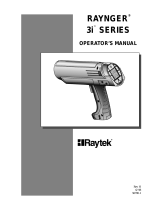Page is loading ...

BULLETIN E-90-MIR
MODEL MIR1 INFRARED THERMOMETER
Specifications– Installation and Operating Instructions
DWYER INSTRUMENTS, INC.
Phone: 219/879-8000 www.dwyer-inst.com
P.O. BOX 373 • MICHIGAN CITY, INDIANA 46361, ,U.S.A. Fax: 219/872-9057 e-mail: info@dwyer-inst.com
Lit-By Fax: 888/891-4963
DESCRIPTION
Infrared thermometers sense the energy of an object,
which consists of transmitted energy, emitted energy,
and reflected energy. An infrared thermometer’s lens,
pointed at an object, collects and focuses the energy
onto the infrared detector inside the unit producing a
signal that is translated and displayed on the LCD.
For most applications, objects being measured have
high emissivities (painted, worn, or oxidized metals,
plastics, rubber, paper). The MIR1 infrared thermometer
has a fixed emissivity set at 0.95. See table 1 for emis-
sivity values for various materials.
OPERATION
Turn the unit on by pressing the ON/HOLD button. The
meter automatically turns off approximately 5 seconds
after the ON/HOLD button is released.
Press the ON/HOLD button to take readings. Read the
temperature on the LCD.
Select temperature units (°F or °C) by first pressing and
holding the ON/HOLD button and then pressing the C/F
button momentarily until the desired units are shown on
the LCD. The units character will blink on the LCD while
programming. Release all buttons when completed.
The MIR1 automatically holds the last temperature read-
ing on the LCD for five seconds after the MEASURE
button is released. No extra button presses are neces-
sary to freeze the displayed reading.
To turn on the LCD backlight, press and hold the
ON/HOLD button and press the BACKLITE button.
Repeat this procedure to turn the backlight off.
PHYSICAL DATA
Range: 0 to 600°F (-20 to 315°C).
Accuracy: ±2% of reading or ±4°F (±2°C) whichever is
greater.
Resolution: 1°C/F.
Sample Rate: 1 second, approximate.
Distance-to-Target Size Ratio: 6:1, nominal.
Response Time: 0.5 seconds.
Emissivity: Fixed at 0.95.
Ambient Operating Temperature: 32 to 122°F (0 to 50
°C), 80% RH max.
Display: 3-digit.
Power: one 9V alkaline (included) .
Power Current: 12 mA DC, approximate.
Weight: 6.4 oz (200 g).
1.56
[40]
2.50
[63.5]
4.50
[114]
6.33
[161]
To turn on the laser, press and hold the ON/HOLD button
and press the LASER button. Repeat this procedure to
turn the laser off.
To take temperature measurements, simply hold the unit
by the handle and point the sensor toward the object to
be measured. The object should be larger than the target
size calculated using a 6:1 distance-to-target-ratio or on
the chart located on the top of the instrument.
The meter automatically compensates for temperature
deviations from ambient temperature. Keep in mind it
will take up to 30 minutes to adjust to wide ambient
temperature changes.
When low temperatures are to be measured followed by
high temperature measurements, some time (several
minutes) is required before the high temperature
measurements can be made accurately.

MEASUREMENT TECHNIQUES
The object should be larger than the target size calcu-
lated using a 6:1 distance-to-target-ratio or on the chart
located on the top of the instrument.
Objects having low emissivity and objects with low
temperatures but high emissivity emit little infrared
energy. Because of this, measurements are adversely
effected by powerful infrared energy radiated from
nearby objects having high emissivity or high tempera-
ture. For example, when such objects are measured in
sunlight, erratic measurements are caused by powerful
radiated energy from the sun reflected on the surface of
the object.
If the surface of an object to be measured is covered in
frost, dust or other material, surface cleaning must be
performed before accurate measurements can be made.
If the surface of an object to be measured is highly
reflective (such as aluminum, brass, chromium, and
stainless steel) apply masking tape or a flat black paint
(both have an emissivity at 0.95) to the surface before
measuring the temperature. Allow time for the tape or
paint to reach equilibrium with the temperature of the
surface below it.
©Copyright 1999 Dwyer instruments, Inc Printed in U.S.A. 10/99 FR R1-443118-00
DWYER INSTRUMENTS, INC.
Phone: 219/879-8000 www.dwyer-inst.com
P.O. BOX 373 • MICHIGAN CITY, INDIANA 46361, ,U.S.A. Fax: 219/872-9057 e-mail: info@dwyer-inst.com
Lit-By Fax: 888/891-4963
BATTERY REPLACEMENT
A flashing display indicates the battery voltage has fallen
into the critical region (6.5 to 7.5 V). Reliable readings
can be obtained for several hours after the first appear-
ance of the low battery indication. Open the battery
compartment, replace the battery, and close the
compartment cover.
MAINTENANCE/REPAIR
AThe MIR1 Mini Infrared Thermometer does not require
routine maitenance. A periodic check of calibration is
recommended. These devices are not field repairable
and should be returned to the factory if recalibration or
other service is required. After first obtaining a Returned
Goods Authorization (RGA) number, send the material,
freight prepaid, to the following address. Please include
a clear description of the problem plus any application
information available.
Dwyer Instruments, Inc.
Attn: Repair Department
102 Indiana Highway 212
Michigan City, IN 46360
EMISSIVITY VALUES
Non-Metals Non-Metals
Material Emissivity Material Emissivity
Asbestos .95 Sand .90
Asphalt .95 Snow .90
Basalt .70 Soil .90-.98
Brick .95 Water .93
Carborundum .90 Wood, natural .90-.95
Ceramic .95
Clay .95
Metals
Concrete .95
Cloth .95
Material Emissivity
Glass Plate .85 Alloy A3003 Oxidized .30
Gravel .95 Brass:
Gypsum .80-.95 Burnished .30
Ice .98 Oxidized .50
Ice Bath .95 Carbon:
Limestone .98 Unoxidized .80-.90
Organic Materials Graphite .70-.80
(food, plants, oil, Iron:
some chemicals) .90-.98 Oxidized .50-.90
Paint (non-Al) .90-.95 Rusted .50-.90
Paper (any color) .95 Wrought, dull .90
Plastic (opaque Lead (Roughened) .40
over 20 mils) .95 Steel:
Rubber .95 Oxidized .70-.90
Cold Rolled .70-.90
NOTE: Noncontact thermometers are not recommended for use in
measuring shiny, polished, or unoxidized metals such as aluminum,
brass, chromium, and stainless steel.
TABLE 1
/




